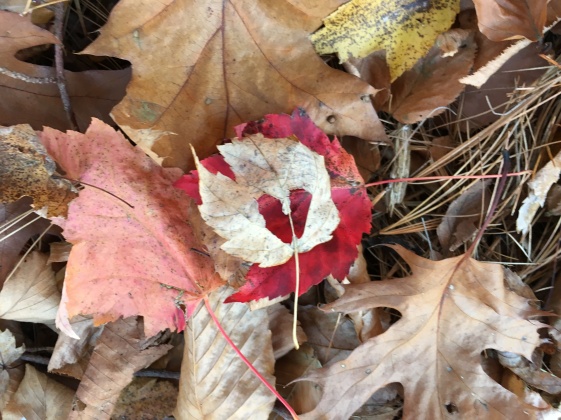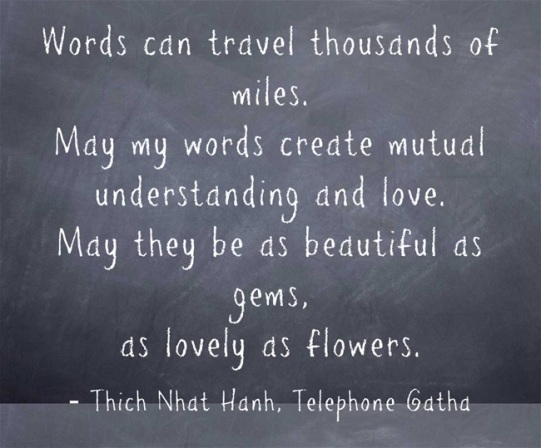
Leaves on the Path Photo by me
“Anger is an acid that can do more harm to the vessel in which it is stored than to anything on which it is poured.”
~ Mark Twain
“The truth must be presented in ways that others can accept. Words that damage or destroy are not Right Speech. Before you speak, understand the person you are speaking to. Consider each word carefully before you say anything, so that your speech is “Right” in both form and content.”
~ Thich Nhat Hanh
“You will not be punished for your anger, you will be punished by your anger.”
~ Siddhartha Gotama
“Speak when you are angry—and you’ll make the best speech you’ll ever regret.”
~Laurence J. Peter
Dear Friends,
I hope you are enjoying this new month and are listening to what your mind and body are calling for. This week I want to look at the fourth of The Five Mindfulness Trainings, Loving Speech and Deep Listening. The Five Mindfulness Trainings are a modern adaptation of the Buddha’s ethical guidelines given over 2,500 years ago:
Loving Speech and Deep Listening
Aware of the suffering caused by unmindful speech and the inability to listen to others, I am committed to cultivating loving speech and compassionate listening in order to relieve suffering and to promote reconciliation and peace in myself and among other people, ethnic and religious groups, and nations. Knowing that words can create happiness or suffering, I am committed to speaking truthfully using words that inspire confidence, joy, and hope. When anger is manifesting in me, I am determined not to speak. I will practice mindful breathing and walking in order to recognize and to look deeply into my anger. I know that the roots of anger can be found in my wrong perceptions and lack of understanding of the suffering in myself and in the other person. I will speak and listen in a way that can help myself and the other person to transform suffering and see the way out of difficult situations. I am determined not to spread news that I do not know to be certain and not to utter words that can cause division or discord. I will practice Right Diligence to nourish my capacity for understanding, love, joy, and inclusiveness, and gradually transform anger, violence, and fear that lie deep in my consciousness.
For many people, this is the most difficult training since to live in the world involves communicating. Every day we speak to people. We communicate in all of our relationships, personal and professional. We talk to strangers, our pets, and we often overlook how we speak to ourselves. Every day we experience a gamut of quickly changing sensations and emotions. A conversation may start off easily and happy, then quickly turn irritating and lead to bitterness. We may feel hurt and want to hurt the other person back, lashing out with accusations, cutting sarcasm, or punishing with our silence.
The fourth training is closely tied with handling our emotions, specifically our anger. If we do not know how to deal our anger we will run the risk of transmitting shame, fear, and violence. We also plant the seeds of this continued rage in the other person. I can speak to this and the transformation that occurred in my life using the fourth mindfulness training. I grew up in a family that had generational rage. As a child, I didn’t know that rage was abuse. I didn’t know about mirror neurons, part of the autonomic nervous system, that allow humans and high order animals to absorb behaviors. Witnessing a repeated activity, the neural patterns in the brain light up in the sequence of the observed action. This is the way babies learn. When we are raged at, there is intense shame, but the child who hides and fears also learns. We are trained to recreate our experience.
The first time I went to Sangha, we read the Five Mindfulness Trainings. The line that caught me was, “When anger is manifesting in me, I am determined not to speak. I will practice mindful breathing and walking in order to recognize and to look deeply into my anger.” That sentence could have been written in Vietnamese. I had no idea what that meant, nor had I ever experience anyone doing that. I only knew rage and silence. Caring for my anger sounded impossible. I mean, who does that? What did that even look like?
After several years of practice, I recognized that the rage I witnessed as a child was manifesting in me and through me. I was actively transmitting this rage to my children, exactly the way it was transmitted to me. I realized that I did not want to pass this family inheritance on. I wanted it to end with me.
I got my opportunity to put this into practice quickly enough. My kids made some mess and left it. It was the end of a long day and I was tired. I felt the familiar rise in me welling up, my rage coming to the surface. I couldn’t be near this mess and keep it together. Without a word, I walked out the door into darkness. Rain was falling. Every cell in my body was screaming for release. I took a step and felt my foot on the ground. I breathed. The rain hit my cheeks like someone else’s tears. I took another step. I couldn’t hold this feeling. It was too big. I couldn’t do this. I felt like I was tied to a chair, restrained. I wanted that rage so badly. It was a hunger in my body, the need to discharge this burden.
I didn’t know about neuro-receptor sites and how repeated behavior creates chemical addiction in the body. I didn’t know that anger and rage are rewarded with dopamine, the same way cocaine or alcohol reward the addict. I didn’t know that not being able to stop a behavior is called addiction. “Take a step. Breathe” I said. “Just this one. Just this one.” I don’t know for how long I walked and breathed. It felt like a lifetime. When my rage stopped, I was outside in the cool air, breathing, feeling a new feeling—sadness. No one saw me, including myself. But I was standing there, ready and willing to listen and care for these feelings I had ignored for so long. The next time I broke the chain of rage was just as hard, but I lived through the first time, so I knew I could do it. The third time was easier. Each time I remember that I cannot speak when I am in the grip of this fury. There’s too much at stake.
This is what mindfulness does for me. It enables me to notice my feelings, the creeping irritation, the sadness, loneliness, the overwhelm. It lets me hold the hand of the little one who did not get shielded, who faced the rage alone. When she is scared, I can help her. We help each other. I know that the rage is not my fault—nor the fault of my ancestors. Now I am aware of sensations in my body. I stop. I hear the cry of need in me before it escapes as pain for those around me. My rage is cooled enough to see the loneliness and helplessness beneath it from long ago.
Dharma teacher Michael Grady once said, “when I don’t blaze away in anger, I don’t have as much apologizing to do.” I have found this to be true 100% of the time. When we learn to care for our emotions, we can be present for ourselves and learn to take care of others through our communication. We become aware of how important our words are. They are our legacy and our speech also creates our future. During this week I invite you to look at your communication, at the amount of kindness and understanding that are in your words, especially the silent words we speak to ourselves. Do we say things to ourselves we would never say out loud to anyone else? Do we treat ourselves with as much respect and care, as we do our closest friend? I hope the answer can be—yes! Loving speech is a heart practice, opening to listen to what we are needing—maybe it’s a break, some comfort, or just to hear we care about our pain. Thich Nhat Hanh says, “Darling, I am here for you.” Please use your gift of speech carefully, especially with our children. The future is at stake.
May we all trust our light,
Celia

A beautiful reminder for myself before signing in to an online sangha this morning. 😊
LikeLike